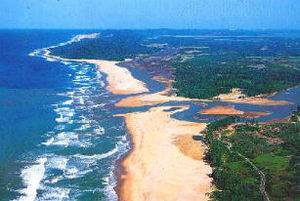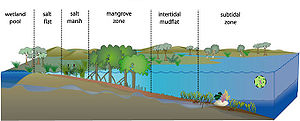Estuaries: Difference between revisions
| Line 19: | Line 19: | ||
==The importance of estuary== | ==The importance of estuary== | ||
The productivity and variety of estuarine habitats support a wonderful abundance and diversity of species. Thousands of species of fish, shore birds, marine mammals, clams, shellfish and other widelife survival in and around estuarine habitats.Many fish and shellfish species, including most commercially and recreationally important species, depend on the sheltered waters of estuaries as home to spawn and for their offspring to grow and live. Because the high productivity of living organism, migratory birds also take estuaries as ideal places for resting and reproducing. | The productivity and variety of estuarine habitats support a wonderful abundance and diversity of species. Thousands of species of fish, shore birds, marine mammals, clams, shellfish and other widelife survival in and around estuarine habitats.Many fish and shellfish species, including most commercially and recreationally important species, depend on the sheltered waters of estuaries as home to spawn and for their offspring to grow and live. Because the high productivity of living organism, migratory birds also take estuaries as ideal places for resting and reproducing. | ||
In addition to serving as important habitat for wildlife, estuaries also provide valuable environmental services. The water flowing to ocean carries sediments, organic and inorganic nutrients and pollutants. Much of the sediments and pollutants are filtered out when they flows through wetlands, swamps and salt marshes. This filtration prcoess deposits harmful pollutants and then creates an environment for microbes biodegrade these sediments. Estuaries plants also can absorb tide and storm surges, providing peaceful and stable habitats for widelife.This natural buffer also help prevent erosion and stabilize the coast. | |||
In addition to serving as important habitat for wildlife, estuaries also provide valuable environmental services. The water flowing to ocean carries sediments, organic and inorganic nutrients and pollutants. Much of the sediments and pollutants are filtered out when they flows through wetlands, swamps and salt marshes. This filtration prcoess deposits harmful pollutants and then creates an environment for microbes biodegrade these sediments. Estuaries plants also can absorb tide and storm surges, providing peaceful and stable habitats for widelife.This natural buffer also help prevent erosion and stabilize the coast. | |||
The transition character of estuaries provide important research value for scientists.Wide range of problems in biology, geology, chemistry, physics, sociology are studied in and around estuaries. Estuaries also provide a great deal of aesthetic enjoyment for the people who live, work, or recreate in and around them.[[http://www.epa.gov/owow/estuaries/about.html]] | The transition character of estuaries provide important research value for scientists.Wide range of problems in biology, geology, chemistry, physics, sociology are studied in and around estuaries. Estuaries also provide a great deal of aesthetic enjoyment for the people who live, work, or recreate in and around them.[[http://www.epa.gov/owow/estuaries/about.html]] | ||
Revision as of 05:28, 28 March 2010
Introduction=
At right is a sample image insertion. It works for any image uploaded anywhere to MicrobeWiki. The insertion code consists of:
Double brackets: [[
Filename: PHIL_1181_lores.jpg
Thumbnail status: |thumb|
Pixel size: |300px|
Placement on page: |right|
Legend/credit: Electron micrograph of the Ebola Zaire virus. This was the first photo ever taken of the virus, on 10/13/1976. By Dr. F.A. Murphy, now at U.C. Davis, then at the CDC.
Closed double brackets: ]]
Other examples:
Bold
Italic
Subscript: H2O
Superscript: Fe3+
An estuary is a partly enclosed coastal body of water with one or more rivers or streams flowing into it, and with a free connection to the open sea[[1]].Thus estuary provides transition zones between the fresh water of rivers and the saline environment of the sea.This interaction produces a unique environment that supports diverse habitats for a wide variety of living organisms.[[2]].
The importance of estuary
The productivity and variety of estuarine habitats support a wonderful abundance and diversity of species. Thousands of species of fish, shore birds, marine mammals, clams, shellfish and other widelife survival in and around estuarine habitats.Many fish and shellfish species, including most commercially and recreationally important species, depend on the sheltered waters of estuaries as home to spawn and for their offspring to grow and live. Because the high productivity of living organism, migratory birds also take estuaries as ideal places for resting and reproducing.
In addition to serving as important habitat for wildlife, estuaries also provide valuable environmental services. The water flowing to ocean carries sediments, organic and inorganic nutrients and pollutants. Much of the sediments and pollutants are filtered out when they flows through wetlands, swamps and salt marshes. This filtration prcoess deposits harmful pollutants and then creates an environment for microbes biodegrade these sediments. Estuaries plants also can absorb tide and storm surges, providing peaceful and stable habitats for widelife.This natural buffer also help prevent erosion and stabilize the coast.
The transition character of estuaries provide important research value for scientists.Wide range of problems in biology, geology, chemistry, physics, sociology are studied in and around estuaries. Estuaries also provide a great deal of aesthetic enjoyment for the people who live, work, or recreate in and around them.[[3]]
Physical environment
Describe the physical and chemical characteristics of the environment, using as many sections/subsections as you require. Look at other topics available in MicrobeWiki. Which involve processes similar to yours? Create links where relevant.
Subsection 1
Subsection 1a
Subsection 1b
Subsection 2
Biological interactions
Are there important biological interactions that are important in this environment? Do these interactions influence microbial populations and their activities? How do these interactions influence other organisms? Describe biological interactions that might take place in this environment, using as many sections/subsections as you require. Look at other topics available in MicrobeWiki. Create links where relevant.
Subsection 1
Subsection 1a
Subsection 1b
Subsection 2
Microbial processes
What microbial processes define this environment? Describe microbial processes that are important in this habitat, adding sections/subsections as needed. Look at other topics in MicrobeWiki. Are some of these processes already described? Create links where relevant.
Subsection 1
Subsection 1a
Subsection 1b
Subsection 2
Key Microorganisms
What kind of microbes do we typically find in this environment? Or associated with important processes in this environment? Describe key groups of microbes that we find in this environment, and any special adaptations they may have evolved to survive in this environment. Add sections/subsections as needed. Look at other microbe listings in MicrobeWiki. Are some of the groups of microbes from your environment already described? Create links to those pages. Specific microbial populations will be included in the next section.
Subsection 1
Subsection 1a
Subsection 1b
Subsection 2
Examples of organisms within the group
List examples of specific microbes that represent key groups or are associated with important processes found in this environment. Link to other MicrobeWiki pages where possible.
Current Research
1. Ammonia-oxidizing archaea (AOA) are ubiquitous and abundant in marine waters and sediments, they contributes to the N cycle in estuarine and coastal environments through coupled nitrification–denitrification or nitrification–anammox (anaerobic oxidation of ammonium) processes. Dang studies the sedimentary AOA diversity, amoA genotype communities and spatial distribution in the Changjiang Estuary and the adjacent East China Sea. Results indicated the gradients of surface-water salinity and sediment sorting coefficient are significantly correlated with the distribution of AOA communities.The archaeal amoA sequences had quite high similarity with known sequences from various soil environments or coastal and estuarine environments of the East Pacific Ocean, suggesting that similar archaeal AOA communities might exist in similar estuarine environments across the geographical distance(Dang HY,2008). Caffrey studied the abundance of ammonia-oxidizing bacteria (AOB) and AOA amoA genes in six different estuaries at multiple sites.AOA rather than AOB are responsible for much of the nitrification in estuarine sediments.The potential nitrification rates increased as abundance of AOA amoA increased, suggesting that AOA are more significant than AOB in estuarine nitrogen cycling(Jane M Caffrey,2007).
2.In bottom waters of stratified estuaries,oxygen consumed primarily by bacteria exceed atmospheric and photosynthetic reoxygenation.This anoxic environmental inhibit most living marine species, but large number of bacteria and protists are still active by changing their metabolism to anaerobic respirations.The activity and phylogenetic composition of bacterioplankton communities across hypoxia/anoxia estuaries were studied. Bacterioplankton communities in anoxic estuaries of the Chesapeake Bay were very similar to those in oxic surface waters in summer even when oxygen respiration shifted to nitrate respiration, suggesting functional redundancy appearance.The forms of respiration used by bacterioplankton control redox conditions, which generate feedback to the phylogenetic composition of bacterioplankton communities ultimately. Estuaries are periodically refreshed with oxygen and chemical sediments from ocean, thus bacterioplankton community shift their respiratory processes and phylogenetic composition as chemical conditions change seasonally(B C. Crump, 2007).
3. The bioremediation potentials of microbes in different environments are hot topics for microbiologists. Some estuaries near urban and industrial areas received high inputs of a large variety of micro-pollutants including polycyclic aromatic hydrocarbons (PAHs).PAHs are toxic, mutagenic and carcinogenic for human health and the environment. Examination of the ecology of PAH degrading microorganisms is thus essential to prevent ecological damage caused by organic pollutants in estuary ecosystem. Research have found that a large number of bacterial species are able to bio-degrade PAHs,but the diversity of the bacterial community are also dramatically reduced due to special carbon source availability in PAHs pollutants. Analysis of the 16S rRNA gene sequences confirmed that Cycloclasticus spp., play an universal key role in degradation of low-molecular-weight PAHs in marine environments. Additionally, Pseudomonas spp.[[4]], considered as a good PAH-degrading bacterial group in soil or in sediment, also increased their competition and adaptation in PAHs degradation in the seawater macrocosm(Niepceron,2010).
References
Edited by student of Angela Kent at the University of Illinois at Urbana-Champaign.


